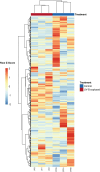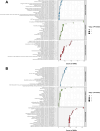Transcriptional responses of Metarhizium pingshaense blastospores after UV-B irradiation
- PMID: 39703704
- PMCID: PMC11656200
- DOI: 10.3389/fmicb.2024.1507931
Transcriptional responses of Metarhizium pingshaense blastospores after UV-B irradiation
Abstract
Metarhizium is widely known for its role as an arthropod biocontrol agent and plant bioinoculant. By using mass-production industrial methods, it is possible to produce large amounts of fungal single-celled propagules (including blastospores) to be applied in the field. However, in the environment, the solar ultraviolet components (particularly UV-B) can harm the fungus, negatively impacting its pathogenicity toward the arthropod pest. The present study is the first to use comparative genome-wide transcriptome analyses to unveil changes in gene expression between Metarhizium pingshaense blastospores exposed or not to UV-B. Relative blastospores culturability was calculated 72 h after UV-B exposure and exhibited 100% culturability. In total, 6.57% (n = 728) out of 11,076 predicted genes in M. pingshaense were differentially expressed after UV-B exposure: 320 genes (44%; 320/728) were upregulated and 408 (56%; 408/720) were downregulated in the UV-B exposed blastospores. Results unveiled differentially expressed gene sets related to fungal virulence, production of secondary metabolites, and DNA repair associated with UV damage; genes related to virulence factors were downregulated, and genes associated with nucleotide excision repair were upregulated. These findings illustrate critical aspects of Metarhizium blastospores strategies to overcome UV-B damage and survive solar radiation exposures in insulated fields.
Keywords: RNA-seq; bioinputs; entomopathogenic fungi; insect control; tolerance to UV-B.
Copyright © 2024 Corval, Carvalho, Mesquita, Fiorotti, Corrêa, Bório, Carneiro, Pinheiro, Coelho, Santos, Fernandes, Angelo, Bittencourt and Golo.
Conflict of interest statement
The authors declare that the research was conducted in the absence of any commercial or financial relationships that could be construed as a potential conflict of interest. The authors declared that they were an editorial board member of Frontiers, at the time of submission. This had no impact on the peer review process and the final decision.
Figures





References
-
- Andrews S. (2010). FastQC: A quality control tool for high throughput sequence data. Cambridge: Babraham Bioinformatics, Babraham Institute.
-
- Bernardo C. C., Barreto L. P., Silva C. R. S., Luz C., Arruda W., Fernandes E. K. K. (2018). Conidia and blastospores of Metarhizium spp. and Beauveria bassiana s.l.: Their development during the infection process and virulence against the tick Rhipicephalus microplus. Ticks Tick Borne Dis. 9 1334–1342. 10.1016/j.ttbdis.2018.06.001 - DOI - PubMed
LinkOut - more resources
Full Text Sources

